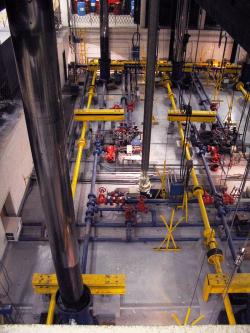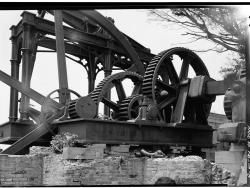The La Esperanza sugar mill steam engine is one of the few remaining American links to the pioneer beam engines of the English inventors Thomas Newcomen (1712) and James Watt (1769). The engine was built in 1861 in Cold Spring, New York, by the West Point Foundry. The general arrangement and details, including the Gothic embellishment, are typical of machinery of the period. The straight-line motion of the piston rod is accommodated to the arc of the moving beam end by a parallel motion. Watt regarded this ingenious linkage as the invention of which he was most proud.
Piston


The precision "choreographed" staging of Radio City Music Hall offers size and versatility, unlike any other. Built in 1932 by Peter Clark, its innovative elevator system is a forerunner of other stage designs (including the Metropolitan Opera House) as well as aircraft carrier systems built in World War II. These elevators can handle people, animals, props and scenery at variable speeds, delivering them to the stage or above and also dropping out of sight in front to reappear again in the back, just as effectively.
Innovations

The precision "choreographed" staging of Radio City Music Hall offers size and versatility, unlike any other. Built in 1932 by Peter Clark, its innovative elevator system is a forerunner of other stage designs (including the Metropolitan Opera House) as well as aircraft carrier systems built in…
Read More
The La Esperanza sugar mill steam engine is one of the few remaining American links to the pioneer beam engines of the English inventors Thomas Newcomen (1712) and James Watt (1769). The engine was built in 1861 in Cold Spring, New York, by the West Point Foundry. The general arrangement and…
Read More

